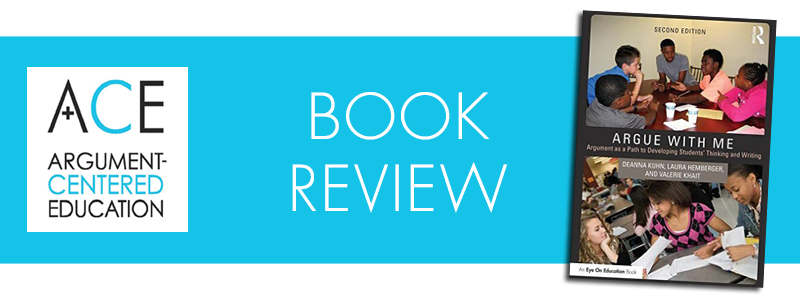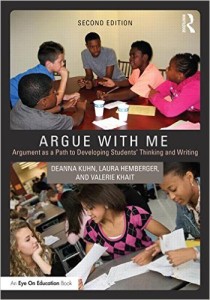
Book Review: ‘Argue with Me,’ 2nd Edition (Routledge, 2015), by Deanna Kuhn et al
Dr. Deanna Kuhn, professor of education and psychology at Columbia University, has been writing about and closely researching the use of argumentation strategies in K-12 education for 20 years. Professor Kuhn’s work has helped blaze a trail for the application of an argument-centered instructional approach throughout the K-12 curriculum. She has the force of a triple-threat: her books present the pedagogical theory for classroom instruction through argument, she (along with her co-authors on Argue with Me) have put together some of the basic building blocks of an argument-based curriculum, and she has conducted highly credible academic research demonstrating the undeniable performance gains that middle school students experience when required to build and make arguments throughout their literacy instruction.
So the new publication of a second edition of her most recent book is an event for professionals in the argument-education field, like us at The Debatifier. We are very pleased to report that Argue with Me: Argument as a Path to Developing Students’ Thinking and Writing (Routledge, 2015) doesn’t disappoint our keen anticipations.
Professor Kuhn begins this work with a reminder of argument’s significance as an intrinsic educational process.
Arguing in fact has been claimed by cognitive scientists to be not just central to human thinking and reasoning but its central objective. Oaksford et al characterize argument as the umbrella under which all reasoning lies: it is ‘the more general human process of which more specific forms of reasoning are a part.’ Possibly, then, the new standards [e.g., Common Core] are getting to the heart of the matter of thinking well.
Kuhn lays out several premises for her work building curriculum and instruction around argument. One is that argumentative claims must be about something arguable. ‘Genuine claims are ones that can be reasonably opposed. They are claims open to meaningful challenge.’ A related premise is that structured argumentation activities in which students are speaking and listening motivate and offer context for student writing and reading. ‘Dialog as a path to the development of argumentative writing is in fact the core idea on which our curriculum is based.’ And ‘producing arguments puts students on the most fruitful path to gaining skill in evaluating them’ in their reading.
Kuhn helpfully distinguishes between the terms ‘argument’ and ‘argumentation.’ For Kuhn, ‘an argument is normally a static product.’ It is what is produced, then read or heard. ‘Argumentation, in contrast, is a . . . social process, engaged in by at least two people.’ This conceptualization links back to the first premise above, that arguments should be debatable so that they can take place within the context of argumentation. This leads Kuhn to place a well-warranted emphasis on what Argument-Centered Education calls ‘refutation’ (a term we define in the broadest sense of ‘engaging and differing with another point of view’), so that ideas should always be engaging other ideas in the classroom and in student work. ‘A critical attribute of argumentative discourse [is] the speakers coming to recognize that to advance the dialog they must speak to one another. In other words, the second speaker’s utterance is constrained by the need to address what the first speaker has said and to do so in a way that will be comprehensible to the first speaker.’ The process of ‘refutation’ elevates the academic quotient of argument-centered instruction over even highly student-centered discussion-oriented classrooms, in which, as Kuhn avers, ‘students most often do little in the way of significant idea exchange. Instead, the teacher is the center and students the spokes of a wheel.’
The curriculum in Argue with Me consists of a highly developed structured argumentation activity that culminates in a specific, classroom-wide version of Showdown Debates, followed by an argumentative essay. The structured argumentation activity includes several distinctive and innovative features. For one, it uses ‘reason cards’ in the argument-building process. Students placed in groups each formulate a reason to support their overall position on a debatable issue (the book includes an appendix entry listing 25 controversies, including the death penalty, organ sale, should juveniles who commit heinous crimes be tried as adults, etc.). Students share their ‘reason card’ with another group member, who tries to write a ‘fewer words’ version of the reason. Then the cards are discussed by the whole group: duplicates are clipped together, with the best-formulated version at the top, and the overall collection of reasons is ranked by stacking cards with the best reason at the top. These ‘reason cards’ then get applied to counter-argument builder and refutation builder graphic organizers, similar to those developed and used by Argument-Centered Education.
Another interesting feature – one that is practically begging to be borrowed – is a platform of argumentation ‘gaming’ (as it’s called in the book) that is computer-based. Kuhn et al mention that various formats are usable, though they recommend Google Chat or simultaneously editable trackers shared on Google Drive. Student-pairs from one side of the issue are matched with pairs on the other side and they engage in informal back and forth, each side presenting reasons, countering the other side’s reasons, and refuting the other side’s counter-arguments. This computer gaming ends with reflection sheets, on which students identify the other side’s best arguments and try to improve on the counter-arguments they made, and identify the other side’s best counter-arguments and try to improve on the refutation they used. The curriculum in Argue with Me builds to a Showdown Debate in which the two big groups, on either side of the debatable issue, send up individual students to face off in the ‘hot seat’ for two minute rounds, earning points for using evidence, counter-arguing, and refuting counter-arguments. Students then write an argumentative essay for which they can take the overall position of either side, using arguments and evidence raised in the Showdown Debate. Though the authors describe the curriculum as flexible in time and scope – and it is certainly highly adaptable in relation to disciplinary content – there are about three weeks’ worth of daily sessions included.
The research results recounted and discussed in Argue with Me focus on the kind of argumentational techniques students demonstrate in their writing when taught using this argument-centered approach compared with students taught using more ‘traditional’ discussion-based curricula. In particular Professor Kuhn and her team measure the frequency of evidence use and ‘dual-perspective’ (or what Argument-Centered Education would call ‘refutational’) instances, i.e., when the student addresses a counter-argument or evaluates competing claims or contradictory pieces of evidence backing claims. The research done for the book finds a very dramatic impact on student writing in the ‘intervention’ classrooms. In one section, for instance, data is cited that students make on average four times as many ‘dual-perspective arguments’ in the argument-centered curriculum versus the control group. In another cut of the data:
‘However’ arguments [another term for ‘dual-perspective arguments’], we found, are rare initially (an average of less than one per essay) but increase significantly over time to an average of almost three (2.95) per essay. In the initial 6th grade essay just over a third of students make even one ‘however’ argument; by the final 7th-grade essay 95 percent do.
It is through classroom argumentation and debating that students become attuned both to the need and to the method of addressing other points of view – the essence of academic argument.
The dialogic structure of their argumentation with peers has clearly made its way into the writers’ essays (‘Others might say . . . ‘). It is this continuing experience of dialog with a succession of peers holding an opposing position, we believe, that makes this opposing position on and is accompanying arguments clear and vivid, enough so that the student undertaking to write an individual essay on the topic is able to represent them in the essay and address them in more than a surface way. And, perhaps most important, students recognize the importance of doing so.
This last point is especially important to Professor Kuhn. Her team identifies a striking increase in the amount of ‘discourse about discourse,’ or ‘metatalk’ in transcripts of students’ argumentation gaming and Showdown Debates – when they ask each other questions such as, ‘How do you know that is true?’ and ‘Did you have any response to our second reason?’ These are indicators that students are coming to understand the ‘academic game,’ the dominant modality of schooling, through college and even graduate school. This metacognitive effect applies to the other major pillar of argument-centered instruction, the use of evidence. ‘Thinking about evidence is intellectually demanding because it entails thinking about thinking, or metacognition. Evidence serves as a reason for a reason.’ In the end, for Kuhn, Hemberger, and Khait, the illumination that argument-centered instruction casts onto the means of performing academic work, and the way that it even instills in students academic values, may be as important as its positive impact on student writing. Though of course these are at a deeply-rooted level closely related, even likely intertwined.
It should be obvious by now that we at Argument-Centered Education find very little to disagree with in Argue with Me. There is this or that detail in the curriculum that I would alter or adapt. The teacher’s role in evidence gathering strikes me as both in need of some ‘gradual release’ to students and not easily implemented. The ‘argument mapping’ the book includes I think is done better by the ‘flow sheets’ that Argument-Centered Education uses because flow sheets track the development of argumentation whereas maps track the continuous series of back-and-forth speaking; it’s more important to record argument substance than it is to transcribe what each person said in sequence. And the book’s suggested topics are fine as controversial issues, but we are committed to argumentalizing regular curriculum in English, science, history, social science, and math, not limiting classroom debating to obvious debatable topics like abortion and euthanasia. Nevertheless, our agreements with the authors overwhelm our differences. Argue with Me is lucid and persuasive theorizing about the vast significance of argumentation for K-12 education; it comprises a very practical classroom-ready curricular project to get students debating on binary issues; and it is a compelling research report on the impact of argument-centered instruction.


